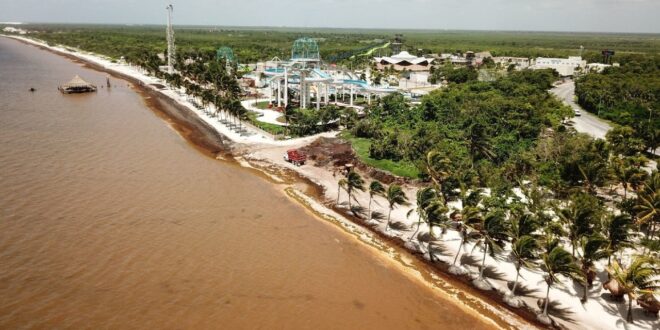QUINTANA ROO, (July 01, 2021).- Satellite images from the United States National Aeronautics and Space Administration (NASA) show that large patches of sargassum are located in the Atlantic Ocean bound for Quintana Roo.
Luís Cardeña, general director of Public Services of Puerto Morelos, reported that “in a NASA satellite image we have a significant patch of sargassum approaching the shores of the Mexican Caribbean.”
The red dots represent sargassum, the satellite image shows the amount, its direction, and a comparison of the seaweed recall since 2016, so this 2021 is so far the most intense.
“Sadly every day we have large patches of sargassum, we are removing approximately between 50 to 90 tons of sargassum per day. We are talking about two kilometers of public beaches, ” said Luís Cardeña.
The graph of June 30 from the Sargasso Monitoring Network in Quintana Roo shows the degree of affectation of 80 beaches from Tulum to Lázaro Cárdenas and in 25 there is an excess of algae, in 19 it is abundant and in 4 moderate.
Beaches like Akumal and Tulum are saturated with seaweed, that is rapidly decomposing once it’s out of the water, causing a terrible stench that is scaring the tourists away from the beach.
Solidaridad is the most affected municipality in Quintana Roo.
In Playa del Carmen, in Solidaridad, we can see tons of algae that continue to reach the beach.
Domingo collects sargassum in the sea and Armando extracts it with his tractor, they are the first line of combat for the algae to prevent it from decomposing.
Armando Madrigal, a brigadista in Puerto Morelos, commented: “We are trying our best to collect as much seaweed as possible before ith reaches the shore, but the amount is overwhelming.”
Cristian Alain, a brigadista in Puerto Morelos, said: “People from Solidaridad (including children) are trying to clean up the beaches, but our efforts are insufficient because we can’t cope with the situation.”
Cristian helps collect sargassum, he is a boatman, but he has done badly this year.
There are no tourists in the sea, they prefer not to go into the water.
This week more than two kilometers of anti-sargassum barriers will be placed, in addition to brigade members on land and three Navy ships that collect the sargassum before it reaches land.


